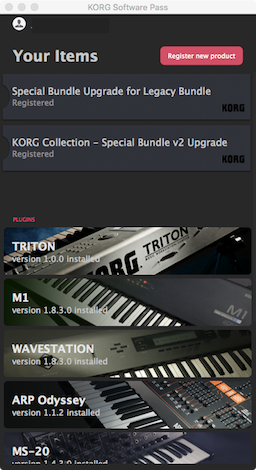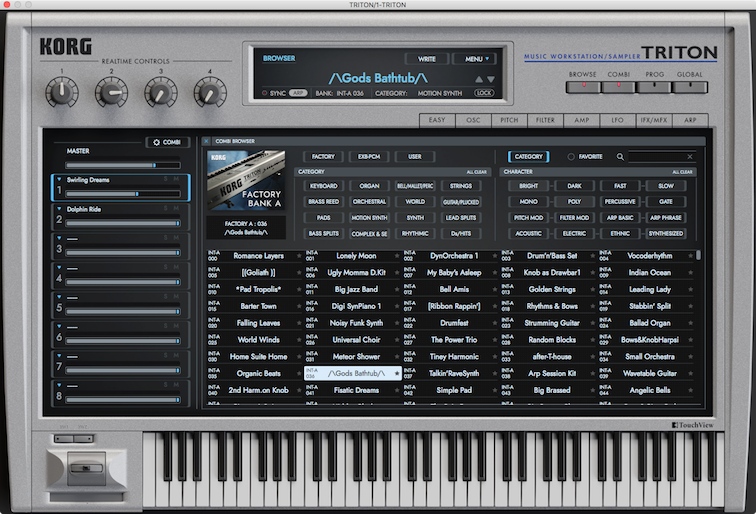KORG Triton Resurrection!
I spent the latter part of 2019 looking for a used KORG Triton-Rack sound module at a price that wouldn't break the bank. Finally I found one on eBay, and when I received it, I noticed that it came with the EXB-PCM05 expansion. So I had my Triton situation sorted out.
Two weeks later, KORG out put a teaser video with the unmistakable profile of a Triton hidden in dark shadows. On December 26, 2019 the KORG Triton plug-in was released. Suddenly I had to get my Triton situation sorted out again.
The KORG Triton is available in the KORG Collection in VST, Audio Unit and AAX formats, with all the original expansions included. The total number of sounds is about 4,000. These are the Triton sounds you hear on records, which may be a good thing or bad depending on your viewpoint.
Why Triton matters
For some time now I've been collecting digital synths, mostly rack modules due to lack of space, but also some keyboards. I've tried to include representative examples of synths from the 1980s and 1990s, but at some point I realized that I was missing a synth or two from the 2000s.
The Noughties were a difficult time for hardware synths in many ways. Virtual instruments were starting to appear more and more, and as they improved, it seemed almost like hardware synths were doomed -- especially digital synths, since they are essentially special-purpose computers with a CPU and some RAM. Desktop computers could be used to surf the web, compose e-mail, run spreadsheets and more, but they could also be used to record sound and run virtual instruments. Most digital synths couldn't even record, and while samplers obviously could, they suffered from lack of memory and storage compared to desktop computers.
In many cases the new virtual instruments in VST and AU formats were running similar on even the exact same DSP algorithms than those embedded in a digital synth, but with much more flexibility. They could be updated easily, and new features could be added quickly. Manufacturers of digital synths did offer operating system upgrades, but getting them into the synths was often difficult compared to the new virtual instrument plug-ins. Many virtual instrument makers also began to offer digital modeling of analog circuits, like KORG did with their Legacy Collection.
By the mid-2000s KORG had already started to be a player in the virtual instrument market, but they still made new hardware synths, albeit digital ones. (You would have to wait for the next analog synth from KORG until the year 2010 when the Monotron was released.) The biggest line of KORG synths was the Triton, with many different models released between 1999 and 2004.
Triton in its various incarnations was a huge success, being a complete music workstation (apart from the Triton-Rack, which had no keyboard or sequencer, and no other storage options besides a built-in floppy drive and an optional SCSI expansion). In the hands of The Neptunes, Timbaland and many others the Triton would prove to be one of the ingredients of many a hit record. Even Kylie Minogue's "Can't Get You Out of My Head" was produced on a Triton by Cathy Dennis and Rob Davis in 2001, but is more remembered for that video (try to focus on the sound, OK?).
From Legacy to Collection
The KORG Legacy Collection was originally released in 2004 with classic KORG synthesizers modelled digitally: MS-20, Polysix, and Wavestation (already digital, of course). They were complemented by the Legacy Cell application which allowed you to combine sounds from all these synths. Originally the KLC even came with a controller that replicated the KORG MS-20 in a smaller form factor.
Soon the KLC was split into Digital and Analog editions, with KORG M1 and the MDE-X effects added to the Digital version alongside Wavestation, and with KORG Mono/Poly added to the Analog edition with MS-20 and Polysix.
Some time ago the Analog and Digital versions of the KORG Legacy Collection were merged again into a bundle now called simply KORG Collection. Before the Triton plugin was introduced, the Collection gained another member: the ARP Odyssey. The bundle has been updated over the years as computer OS updates have required changes, but often it has been a long stretch from one update to the next.
The Triton now joins the KORG Collection. All of the instruments can be installed and updated using the new KORG Software Pass application, which requires you to have a KORG ID. You are encouraged to sort out your situation, especially if you have an older version of the KORG Legacy Collection, because you may be entitled to reduced upgrade pricing. Also check if you have a KORG M1 Le license lying around, perhaps bundled with a MIDI controller.

Just a side note: KORG has also a sizable collection of iOS virtual instruments available, along with KORG Gadget, also available for macOS and Windows. Many of the legacy collection plug-ins are also available in Gadget, some in slightly reduced format and under other names.
Triton and on and on
It will be interesting to compare my recently acquired, almost 20 years old Triton-Rack with the even more recently acquired Triton virtual instrument. Sadly, the Triton-Rack does not get even a mention in the Triton plug-in promotional material, but I think it is the perfect rackmount sound module: a huge collection of sounds, a sampler and performance controls.
If you want a workstation class sound collection in a plug-in, there are many other options out there, with possibly better emulations of real instruments. IK Multimedia's SampleTank 4 comes to mind, as do Native Instruments KONTAKT and Steinberg HALion. But this is the Triton.

Of course, the Triton is a powerful sample-based synth in its own right, with a huge selection of waveforms to process with its filters and effects. One thing missing from the plug-in version is of course sampling. It is unknown at the moment if KORG will bring this to the plug-in in an update, but that would definitely elevate the Triton above many other sample-based synth/ROMpler plug-ins, to the upper atmosphere with KONTAKT and HALion. Maybe not for the instrument building facilities, but definitely the expandability with new sounds.
 digitalsynth.net
digitalsynth.net